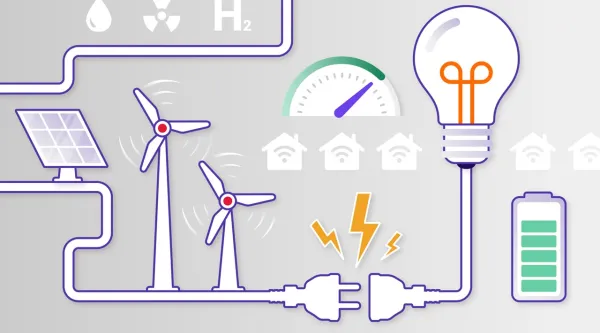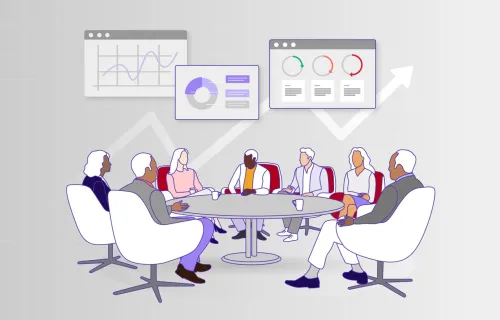As energy leaders face mounting pressure from mandates and market expectations, decarbonization is no longer just a compliance checkbox. It's now a core value driver. Executives are realizing that carbon reduction efforts can unlock hidden efficiencies and improve customer alignment.
AI is playing a pivotal role in navigating grid reliability, compliance and operational efficiency. Leaders are adopting intelligent tools to automate documentation, identify gaps and track evolving regulations in real time. What once felt like an annual audit now requires daily AI-enabled monitoring to meet regulatory expectations.
Success with AI isn’t about spending more—it’s about being more agile. The research shows that high-performing organizations (“Digital leaders”) aren’t investing more than others, but they are breaking down data silos, enabling faster decisions and aligning business and IT.
Talent shortages continue to challenge the sector. As experienced workers retire, AI is stepping in to preserve institutional knowledge. From safety protocols to carbon accounting processes, organizations are embedding intelligence into handheld devices to extend the capabilities of their workforce.
Energy leaders are rethinking operations in the face of global disruption and rising costs. AI is helping drive continuous improvement across processes—from chatbot efficiency to asset utilization—shifting focus from isolated digitization efforts to fully integrated, end-to-end digital operations.
As AI and energy regulations evolve, so does the need for balance. Leaders are investing in systems that not only support compliance but also enable agile responses to change. From Europe’s NIST 2 requirements to growing cybersecurity mandates, AI is becoming a vital support system for navigating complexity.
To move forward, Peter advises energy leaders to focus on business outcomes—not just technology.
Whether it’s cloud strategy, legacy modernization or aligning compliance and innovation, organizations that embed agility, trust and alignment into their strategies are best positioned to lead the energy transition.
- 1. Introduction and key themes from the 2025 CGI Voice of Our Clients research
-
Caroline McNaught:
Hello everyone, welcome back to another episode of our Energy Transition Talks podcast. My name is Caroline McNaught, I'm part of the Global Brand and External Communications team here at CGI and joining me today is CGI's Vice-President and Global Industry Lead for Energy & Utilities, Peter Warren. Peter, can you introduce yourself and your role in the energy and utilities sector?
Peter Warren:
Yeah, Hi Caroline. Thank you very much for that great introduction and thank you for having me today.
Caroline McNaught:
Well, today I'm excited because we'll be discussing the key trends shaping energy and utilities organizations and the insights that will guide their future, based on the newly released 2025 CGI Voice of Our Clients research. In energy and utilities, we spoke with 158 executives to better understand the priorities and strategic shifts ahead. So, with that in mind, Peter, what trends stood out to you this year?
Peter Warren:
Yeah, it was really an interesting year this year when we started talking to different folks. Obviously, AI bubbled to the top, but also the geopolitical challenges that are going on around the world bubble to the top. There were really quite a few areas where everyone was looking for “How do I do more with less? How do I change the world, how do I deal with the budgets that I have?” So, it was really quite a mix of different functions, but I know there were some top trends that were there. Do you want to maybe just highlight them for us, or I can do that.
Caroline McNaught:
Sure, I know that for energy and utilities, we saw a lot around AI. That's not new, but in particular, AI for decarbonization and grid resilience. Across industries as well, workforce transformation and talent shortages seemed to be a key issue. I know in energy and utilities we were seeing that quite a bit. As well, supply chain resilience and risk navigation, regulatory change and a few others that I'm sure we can drill into, but those were some of the top ones that we saw across this industry.
- 2. Decarbonization as both mandate and opportunity
-
Peter Warren:
Yeah, so maybe I’ll take them on one at a time with you here. So—decarbonization. Initially, when decarbonization started and moved forward, I remember one person saying, “This is going to ruin us all. This ESG stuff is going to be terrible for us.” And yes, some of it is mandated and moving forward. But companies are still moving forward with it, not only just because there are governments and mandates to actually decarbonize and lower things, but the entire economy wants to decarbonize in lower end. Given that energy of all forms is scope three—scope three input into every other industry—having this decarbonize is a key component for every other customer of these companies.
They also realized that they can squeeze out inefficiencies. When they started to look at “How do I decarbonize things?” they also realized that they could drive out inefficiencies that they hadn't really realized before. So, this is not only being done because it's mandated, it's being done because the customers want it and it's also because it does drive out inefficiencies.
- 3. AI and regulatory compliance: turning complexity into insight
-
Caroline McNaught:
I know AI came up quite a bit this year. It's hard to avoid it these days. How has AI been playing a role in helping balance sustainability with grid reliability?
Peter Warren:
It's been interesting. One of the cases that we did was with one company was looking at the regulatory compliance. It's interesting. Regulations are very tough for every industry, and I had one client tell me, “If I comply to this, I automatically void that,” and it's kind of a tough thing for them to do.
So what we've been able to do is use AI to help track all of their compliancy, to look at what they're doing, to look at the forms, look at the functions, and bring this forward to them. As in, this very complex form of documents that sometimes are different formats and different alignments—we help them have a dashboard to say, “Hey, how am I doing from a compliancy standpoint and what should I move forward?”
You know, I remember one client talking to us saying that every day is a compliancy day. Every day is another thing. When some of these rules first came out, people were treating it like an annual audit, and they would have a bunch of people get together in a room and they would all come together and say: “This is our best guess.” Now that has become an ongoing process—having tools like AI in all of its formats, scanning documents, compiling things, pointing out failures, pointing out gaps, pulling out misses—something that we need for a day-to-day purpose.
- 4. Data access and agility as success factors in AI adoption
-
Caroline McNaught:
Makes sense. When you talk about compliance, that sounds like a bit of a challenge. What are the biggest challenges utilities face with using AI for resilience, whether that be integrating into existing infrastructure or any other considerations that they may have when approaching that task?
Peter Warren:
Yeah, that's another good point. You know, it really comes down to access at data at pace and scale. The AI systems are as smart as you feed them, and we've all seen or heard of stories where somebody does something and it doesn't really pan out very well because the AI came up with the decision that it said it was going to do. There were some major platforms that came out and were republishing what BBC published as a news announcement. The AI was turning it into something else and effectively creating fake news as it went forward—so having reliable data so that you're not having a hallucination is a key function.
This comes down to some pretty basic organizational restructuring capabilities, having access to data at pace and scale, and the silos that exist in a lot of companies. Those are restricting the benefits they're getting out of AI.
In fact, one of the things we found out when we compared those that were happy with the results—what we call “Digital leaders”—and the ones that weren't, is they're actually both investing money very similarly and actually in very similar ways each other. The difference was that one is more agile—as an organization is responding to the data, dealing with it—but also more agile in the way that they free up the data and don't have the fiefdoms of saying, “No, this is my CIS data or this is my GIS data, and I have methodologies of finding and correcting that data over time.” So, it's much more of a business transformation aspect that we help people with and work with than it is really a technical problem.
- 5. Workforce transformation: meeting talent gaps with digital tools
-
Caroline McNaught:
So interesting. When you talk about transformation, that word seems to apply across the board this year. When we look at workforce transformation and talent shortages, what are we seeing there? How are digital technologies reshaping workforce needs in the energy sector?
Peter Warren:
Yeah, that's another great one. One of our business units—part of the Canadian team in Western Canada—has been doing a publishing series on workforce of the future, specifically because their clients in that part of the world (we see this in other parts of the world) are facing a talent shortage in the oil industry.
To come into Alberta, things are at the point where some universities have actually either cut back or canceled courses simply because younger people weren't signing up for them, and so we've even had to change how we service these clients. In this particular case, we supply that market with a very popular software to do a key function of accounting carbon capture and so on, and the people that run those systems are going to retire in a few years.
So, AI has the opportunity to come in and new systems can come in here and produce the outcomes as these people move forward. It's not to replace the people, because the people are going to leave. It's replacing the function, and we see this across the industry: clients have to start to optimize what they're doing, have their good people focus in on key, high-value processes. This system will then feed this data up to another higher-valued person. They'll say, “Yes, I agree with that,” or, “I don't agree with that.”
And the other one is putting all the function—and we've done this for several different clients and we see other people doing this—consolidating all of the knowledge for the employees into the handheld device that a person can have.
We’ve talked about the aging population for 10 years in this industry—that people are retiring and we have this problem—but up until now there wasn't an easy solution to say how do you get all that data into one place? AI is actually that answer, as it turns out. We can actually scan all those documents, much like that earlier example where I talked about compliancy for regulations. We can scan all the manuals, we can scan all the best practices a company has and put that in the hand of the person, and the person then can not only have it for their primary function, but maybe secondary, third functions. So, employees' functionality can actually broaden, they can do more skills because it's in the palm of their hand and, by the way, this starts with health and safety.
It starts right off: “Are you wearing the right gear? Are you happy enough to do this job today?” all those compliancy things. Then it says, “Okay, now approach it from this direction and do the following.”
- 6. Operational efficiency and resilience amid global disruption
-
Caroline McNaught:
Well, you jumped seamlessly into what was going to be my next question around how roles are evolving with automation and AI. That looks like it's something that isn't going away. So, it's really about making sure you know what you're doing with those tools to enable efficiencies. In that, when we are looking at operations and driving these new efficiencies, we also saw a lot of geopolitical disruption and other factors that are shaping the supply chain. How are energy leaders strengthening operations amid these global disruptions?
Peter Warren:
Yeah, it gets into one of our other areas that you brought up with regulatory and so on, and we touched a bit on compliancy earlier. It's really looking at the total operations of the company and saying: “How do I make it more efficient?” It's value for money, really. It comes down to: “How do I do more with less, how do I get more of a bang for my dollars?” And looking at the entire operation.
So, for us, when we out-task or do a function for somebody, we're using AI to get constant iterative improvements in the way that we look at this and how people are applying this in a variety of different ways. But how do I look at what I'm doing in a process? How do I optimize that? Okay, how do I optimize it again? How do I make it better? How do I make it better?
Ultimately, it gets down to the last five or ten percent that it's too much cost to squeeze that out. But then you move to the next one and look at that and continually look at how to optimize the systems. Maybe if I've got existing chatbots or existing other types of bots in my system—can I see that one's not very busy right now. I can give that one more work before I go start buying other stuff and really looking at the end-to-end process in a digital fashion. That’s the next evolution of the digitization process—people have put digitization in pockets. Now how do I consider it as an end-to-end?
- 7. Adapting to shifting regulations and AI compliance
-
Caroline McNaught:
In that role of navigating regulatory change, how are utilities adapting to these fast-evolving energy and AI regulations?
Peter Warren:
I would say, like the rest of us, they're holding onto their seats and riding it through. It's an ongoing battle and often regulation doesn't keep up with the actual “going-ons” with technology.
In some cases, people are leading and well ahead, and other groups are actually racing to catch up the compliancy of AI—specifically Europe being a leader in that and other people starting to apply it. That's a key function. The NIST 2 security requirements that are happening in Europe and even in the United States, where the critical infrastructure security is being pushed down. They've always had some of these things, but it's all being tightened up both in the governments and in the regulatory area, and it's a constant challenge.
Going back to that, from a project management standpoint, you can have people looking at this, but these people can be also balanced with an AI system that says, “Hey, this is about to go into the red or the yellow, this is not going to be something that you want to miss,” and having systems set up to monitor these processes.
People try to navigate an ever-changing world. This year in our VOC (Voice of the Client), tariffs were highlighted for the first time. I mean we're not surprised at that, but people were saying they need new digital tools, new digital products that will help them manage these. So, they're recognizing the need for it. They're just not quite clear on a product that exists, so AI is becoming that product.
- 8. Embedding agility and organizational alignment
-
Caroline McNaught:
How can companies build agility into their operations to respond to the shifting regulations more effectively?
Peter Warren:
Agility starts, I think, from the top. It starts with a cultural change and this has been always linked as one of the factors that we keep seeing when we start to compare one factor in our Voice of Our Clients to another factor. We see the ones that are getting the benefit out of all of their investments, the leadership, the organization is very agile. There's also an alignment that goes on. So agile doesn't mean chaotic. Agile means that they're responding to what's moving forward and they're dealing with it in a structured fashion.
Believe it or not, agile can be very structured, which is something this industry loves. If you don't do things in a structured fashion, things can catch fire and blow up. You can still have this structure, but you can respond to it in a very different way and have the people understand that this is good for them, have an involvement with it, have the systems being more agile and freeing up this data. That then reinforces this answer that's moving forward.
So, it really comes down from an alignment: business and IT being in sync for companies. We interview somebody from the business side and then somebody from IT, and we compare their answers. If there's a huge gap, that's not a good thing. If they're more or less swimming in the same direction, that's a much better story, as you can imagine, and if the executives are also saying something different—I mean, that's not good. It really comes down to organizational alignment and structure and the ability to respond to what's happening.
- 9. Rethinking legacy modernization and cloud strategy
-
Caroline McNaught:
Fantastic. Well, on that note, that takes us to the last trend that I think really stood out for energy and utilities this year, and that was legacy modernization and innovation. We see across the board, modernizing legacy systems is a major challenge for a number of businesses. Where should organizations start?
Peter Warren:
Yeah, legacy systems are interesting. I use an analogy often with people of renovating a house because people understand that it's a good visual. I am sitting amongst a bunch of tools and things because our house is under renovation. When you renovate something, sometimes you leave a temporary wall in place and that could be a legacy system. If you think about it, you're going to modernize it, you're going to an open concept, but if you take down that wall right now, the ceiling falls in. So suddenly you've got a bungalow from a two-story, so you've got to look at it. How do I move things forward?
There's also the factor of the people that support those systems. You don't want to really replace them if they know the COBOL system or whatever it happens to be, and that's the thing that maintains the second floor. And so digitizing, for digitization's sake, is something that you strategically have to look at: where there's low-hanging fruit, where there's things that are important things, and where I actually have the people that can actually want to do it and can do it. Or, partner with somebody that A: want to do it and B: can do it, and can bring that skill set in.
But look at it from renovating a house, maybe years before you take down that temporary wall. It doesn't mean you're going to paint it. It doesn't mean you're going to hang pictures on it. You can de-risk it by using tools to migrate it maybe off an old piece of hardware. A toy or other systems could recompile it and you could now put it on a lower risk piece of software. But it's going to do the same thing it always did. If it’s printed on purple polka dotted paper, it’s going to print on purple polka dotted paper still. You're not going to get a new function out of it, but it's still supporting the second story until such time as I can have enough infrastructure around to take it down. I think you have to look at it.
- 10. The role of cloud and AI platforms in accelerating innovation
-
Caroline McNaught:
I love that analogy. I'm not sure this would necessarily help a house, but how would cloud and AI platforms accelerate innovation in this area?
Peter Warren:
Yeah, cloud is a huge one and, of course, most AI systems are cloud large language models. We're seeing more and more play in. Dianne Gutiw, our AI VP, doctor of AI wisdom talks about small language models. We're using a lot more small language models for specific functions within a utility or government or other area, when you don't necessarily want to go out to the big external cloud, you want to do things in a controlled fashion, more locally.
I love cloud and we have some clients that have gone to cloud, but then, as the cloud providers continue to raise prices, that's an ongoing consideration for them. Looking at cloud in a balanced way is important: “Where does it offer me a quick acceleration to move forward? But where should I maybe keep some things closer to home?”
We had this debate with one client that's very local to me years ago. They had their outage management system, and one party was saying we should put it all in the cloud. But Canada, where I live, is very prone to ice, storms and even hurricanes, believe it or not, and we get something like 27 tornadoes a year in the area I live, so weather can come in and cause major disruption if you're not careful. And so, could you imagine if you had your outage management team standing there waiting for the network to come back online so you could actually start restoring stuff? Wouldn't be good. That should be local, at least, even at an ER.
Maybe your Monday to Friday version is running on the cloud for efficiencies and access and so on, but the actual cloud, you know a local version is very important and something like that. So, I think it's looking at the function of cloud importantly, but you can still get the benefits of AI at home on a more local platform, maybe even a small language one.
- 11. Looking ahead: Innovation and customer centricity in energy
-
Caroline McNaught:
Well, we've covered almost all the trends. If there's one immediate call to action for energy leaders, Peter, what would you say it is for this time in the landscape?
Peter Warren:
Yeah, it's a good one. I mean, start off with getting your compliancy people and regulatory people, everybody involved with this up front. There's no point in charging off and doing something that is going to get you in trouble from a compliancy standpoint or regulatory standpoint. And start with business cases and application use cases that are business outcome focused, something that's going to drive a positive outcome.
It's not about doing digital twins or digital triplets just for the sake of doing them. As Diane has said before, nobody ever comes to us and says I want an AI thing. They want an outcome. Figure out what that outcome is and then do it in a way that both your security, your compliancy people are all involved with that, so that you do it in a way that is expandable and operational for you. It's all about making things that are operational.
Caroline McNaught:
Makes sense. Now, Peter, on a lighter note, what's one thing giving you optimism about where energy and utilities are headed as an industry?
Peter Warren:
Wow, that's a great one. The innovation. One reason why I love this industry is people do it because they're passionate for it, and so the aspect and the opportunity for this industry is great.
There are a lot of today's existing leaders moving forward in it and there's a lot of new entrants in this industry that's coming forward. That's both a good thing and a bad thing, I guess, but the industry is changing and evolving, and the movement towards producing large amounts of consumable energy more at a local level, amounts of consumable energy more at a local level, more of the diversity of energy sources, the ability to have people use and consume their own energy, but maybe supported by utilities in a function.
If you think about it, I'm not an expert on solar panels and batteries, but I do trust my local utility and always have, so the opportunity for them to be my service provider for something like that that still benefits me and gives me reinforcement is a great idea. So, I think there's going to be a lot of innovation. There's going to be a lot of customer service movement forward, and the customer centricity aspect of all of that I think I'm most keen about.
- 12. Practical advice to close: Focus on outcomes, not tools
-
Caroline McNaught:
Well, Peter, is there anything that we haven't touched on, that you'd love to leave the audience with?
Peter Warren:
Move forward, get on with the bandwagon. Start with the use case, start with your compliancy people, like I said before. Make it practical. When you do that, then the C-suite sees benefit in it. You can start to look at things like with the generative AI, having decisions brought up to you as a outcome. If I've got three or four digital twins moving forward, well that's very nice, but what does it mean to me as a business operator? And that's where maybe the triplet concept of generative AI can come in and say, “Well, these are the things you should consider, given everything else going on,” and that's not just for this industry. That could be manufacturing, that could be a variety of different industries.
Caroline McNaught:
Peter, thank you so much for your time today. It's been fun putting you in the spotlight, as you so generously do to your guests on this podcast. And to anybody listening, be sure to subscribe on Spotify and Apple, and stay tuned for more Energy Transition Talks, episodes in the future.
Peter Warren:
Thank you, Caroline.







